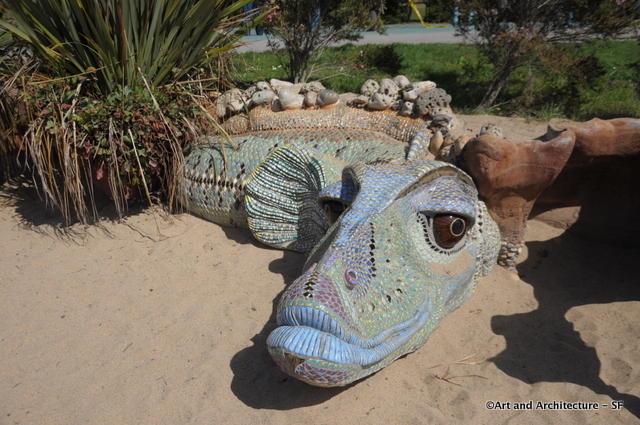Koret Childrens Quarters
Golden Gate Park
This divine sea creature is by Phoebe Palmer.
On an architectural scale, Phoebe is building densely textured, sculptural ferro-cement walls and working in mosaics and metal sculpture as well as her “normal” mediums of paint and pastels. Phoebe has taken the characters formerly inhabiting her paintings and pastels and cast them in the round as she breaks into the classical realm of ceramic sculpture.
This is Palmer’s first piece of public art.
The ferro-cement-and-tile creature weighs nearly a ton and cost about $10,000.
According to San Luis Obispo.com:
From the start, the sea creature was a ‘her,’ Palmer said, “After a while, I just started calling her ‘the beast.’ ”
Palmer did 15 to 20 “little clay models” of the head, each with a different expression. She and Peterson agreed on one that “was somewhat sweeter than what he initially had in mind, I think.”
As always, making art is learning by doing, and “Phoebe always dives right in,” said her husband, Peter Fels.
Palmer made a rebar metal frame for the head and covered it with aviary wire — like chicken wire, only smaller — and metal lath similar to what would be used for plastering.
“Of course, it was harder to get the nice expression in wire than in clay,” she said.
Palmer fashioned the tail and midsection, and cemented the entire sculpture.
She made about 10,000 “little tile scales” out of medium-fire porcelain, roughly 1-inch triangles with a curved bottom. They were fired once, glazed and then fired again.
Other tiles as small as a quarter-inch were needed for the head, “so I would be able to keep her nice expression … It was a pain painting stripes on a quarter-inch tile,” Palmer said with a laugh. “As I kept having to make yet another batch … I muttered about the beast’s voracious appetite for tile.”
She recalled that “trial-and-error was the name of the game.”
It took many glaze experiments and test arrangements of more than 15 types of tiles. Some have a little yellow tip, she said, “and then two or three other glazes applied in stripes or speckles.”
The beast’s “eyes and lips were made out of bigger pieces of ceramic,” clay that shrinks 12 percent in the firing, “so getting the eyes to fit in the eye socket was a challenge.” In fact, she made “about 15 pairs before I got it right, plus tons of 3D glaze samples — the glazes act differently on the curved sample than on a flat one.
“Next time,” she said, “I’d make the eyes first and make the cement to fit them.”
She also made four sets of lips before getting the right color and texture.
In retrospect, Palmer said, everything concerned with such a complex creature took longer than expected. In fact, “even the installation is going slowly, and won’t be completed until the end of March. They are plumbing it to emit mist out of the nostrils.”



It is so well done! I really like it.
Boy look at all the detail in this piece. I really would like to see this in person.